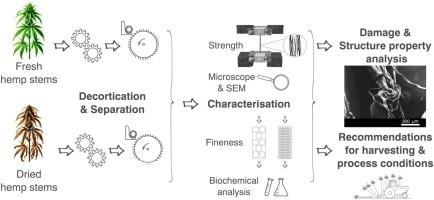当前位置:
X-MOL 学术
›
Ind. Crops Prod.
›
论文详情
Our official English website, www.x-mol.net, welcomes your
feedback! (Note: you will need to create a separate account there.)
Decortication and separation of wet or dry hemp stems - What difference does it make?
Industrial Crops and Products ( IF 5.6 ) Pub Date : 2024-11-18 , DOI: 10.1016/j.indcrop.2024.119965 Jörg Müssig, Johnny Beaugrand
Industrial Crops and Products ( IF 5.6 ) Pub Date : 2024-11-18 , DOI: 10.1016/j.indcrop.2024.119965 Jörg Müssig, Johnny Beaugrand

|
Hemp decortication, a crucial step in fibre processing, traditionally uses dry stems with low water content. However, processing hemp in a wet state has gained attention as an alternative method, especially with the development of harvesting techniques that decorticate the stems directly in the field. We investigated the effects of stems' initial moisture content on hemp fibre functional quality using freshly harvested hemp stems from different varieties. The stems were subjected to wet and dry decortication processes to evaluate potential differences in fibre damage and biochemical composition. Our experiments involved utilising a laboratory roller-breaking device for the initial decortication of the fresh hemp stems in their wet state and subsequent mechanical separation to assess fibre bundle integrity. As a comparison, we performed the same procedure on stems that were first dried before processing. We found that wet processing resulted in higher lignin levels in the fibre bundles, containing a higher quantity of middle lamellas, where lignin or another biochemical marker is typically found. The analysis revealed significant damage to the fibre bundles during the wet decortication process, as evidenced by the destruction and fibrillation of the bundles, clearly visible in scanning electron microscope (SEM) images. Interestingly, the dry conditions led to more fractures between fibres, while wet conditions allowed fractures between bundles and the surrounding histological structure. These findings suggest that wet processing may render the material more ductile, resulting in more complex crack modes, including combined torsion and delamination, leading to fracture paths passing through the cross-section of individual fibres. Consequently, the fibre bundles from wet processing may exhibit more structural damage than dry-processed fibre bundles. In conclusion, our study's findings are important as they highlight the severe damage that can occur to the fibre bundles during the decortication and separation of freshly harvested, moist hemp stems.
中文翻译:

湿麻茎或干麻茎的去皮和分离 - 有什么区别?
大麻脱皮是纤维加工的关键步骤,传统上使用含水量低的干茎。然而,在湿状态下加工大麻作为一种替代方法已经受到关注,特别是随着直接在田间对茎进行去皮的收获技术的发展。我们使用来自不同品种的新鲜收获的大麻茎研究了茎的初始水分含量对大麻纤维功能品质的影响。茎经过湿和干脱皮过程,以评估纤维损伤和生化成分的潜在差异。我们的实验包括利用实验室滚筒断裂装置对湿状态下的新鲜大麻茎进行初始剥脱,然后进行机械分离以评估纤维束的完整性。作为比较,我们对加工前先干燥的茎执行相同的程序。我们发现,湿法加工导致纤维束中的木质素水平更高,含有更多的中间薄片,通常发现木质素或其他生化标志物。分析显示,在湿剥脱过程中,纤维束受到了严重损坏,在扫描电子显微镜 (SEM) 图像中清晰可见的纤维束的破坏和帚化证明了这一点。有趣的是,干燥条件导致纤维之间出现更多的断裂,而潮湿条件允许纤维束与周围组织结构之间发生断裂。这些发现表明,湿法加工可能会使材料更具延展性,从而导致更复杂的裂纹模式,包括组合扭转和分层,导致断裂路径穿过单根纤维的横截面。 因此,湿法加工的纤维束可能比干法加工的纤维束表现出更多的结构损伤。总之,我们的研究结果很重要,因为它们强调了在新鲜收获的潮湿大麻茎的去皮和分离过程中可能对纤维束造成的严重损害。
更新日期:2024-11-18
中文翻译:

湿麻茎或干麻茎的去皮和分离 - 有什么区别?
大麻脱皮是纤维加工的关键步骤,传统上使用含水量低的干茎。然而,在湿状态下加工大麻作为一种替代方法已经受到关注,特别是随着直接在田间对茎进行去皮的收获技术的发展。我们使用来自不同品种的新鲜收获的大麻茎研究了茎的初始水分含量对大麻纤维功能品质的影响。茎经过湿和干脱皮过程,以评估纤维损伤和生化成分的潜在差异。我们的实验包括利用实验室滚筒断裂装置对湿状态下的新鲜大麻茎进行初始剥脱,然后进行机械分离以评估纤维束的完整性。作为比较,我们对加工前先干燥的茎执行相同的程序。我们发现,湿法加工导致纤维束中的木质素水平更高,含有更多的中间薄片,通常发现木质素或其他生化标志物。分析显示,在湿剥脱过程中,纤维束受到了严重损坏,在扫描电子显微镜 (SEM) 图像中清晰可见的纤维束的破坏和帚化证明了这一点。有趣的是,干燥条件导致纤维之间出现更多的断裂,而潮湿条件允许纤维束与周围组织结构之间发生断裂。这些发现表明,湿法加工可能会使材料更具延展性,从而导致更复杂的裂纹模式,包括组合扭转和分层,导致断裂路径穿过单根纤维的横截面。 因此,湿法加工的纤维束可能比干法加工的纤维束表现出更多的结构损伤。总之,我们的研究结果很重要,因为它们强调了在新鲜收获的潮湿大麻茎的去皮和分离过程中可能对纤维束造成的严重损害。


















































 京公网安备 11010802027423号
京公网安备 11010802027423号